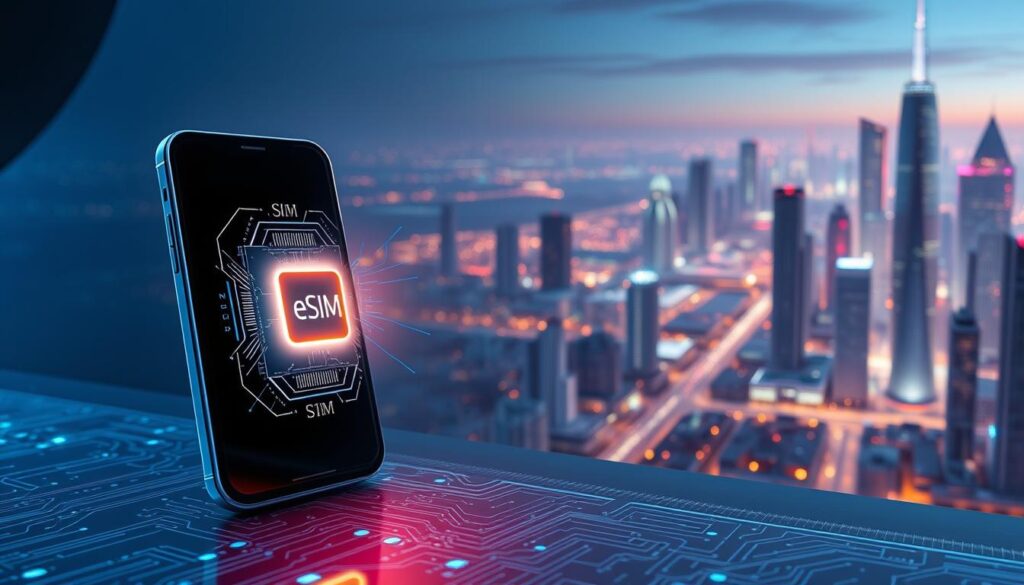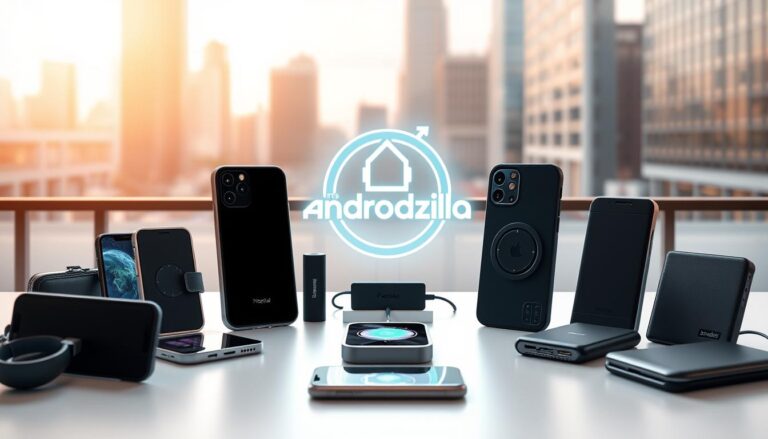
Have you ever felt the frustration of switching carriers or dealing with unreliable connectivity? We’ve all been there. The world of technology is evolving rapidly, and the way we stay connected is no exception. Enter eSIM technology, a game-changer that’s transforming how devices connect globally. This innovation is not just a trend; it’s a solution that’s reshaping industries and simplifying our lives.
From smartphones to IoT devices, eSIMs are making waves by offering flexibility and efficiency. Imagine a world where you can switch carriers remotely without needing a physical card. This is the reality eSIMs bring to the table. With over 130 major international carriers supporting this initiative, the adoption is growing faster than ever1.
In this guide, we’ll explore how this technology is revolutionizing connectivity. We’ll dive into its benefits, from reducing costs to enhancing security. Whether you’re a business owner or a tech enthusiast, understanding eSIMs is crucial for staying ahead in today’s connected world.
Key Takeaways
- eSIMs allow remote carrier switching, eliminating the need for physical SIM cards.
- Over 130 major carriers globally support eSIM technology1.
- This innovation enhances device connectivity and reduces operational costs.
- eSIMs are ideal for IoT devices, offering flexibility and scalability.
- They provide stronger security features, protecting against unauthorized access1.
Building Your eSIM Strategy
To stay ahead in the digital age, businesses must rethink their connectivity approach. A well-crafted strategy ensures seamless integration and long-term success. It starts with understanding both technical and organizational needs.
Assessing Business and Technical Needs
Aligning your goals with technology is the first step. Begin by evaluating device compatibility and network requirements. This ensures your strategy supports current and future demands.
Proper profiling helps streamline logistics and reduce errors. It also identifies the right carrier networks for your needs. This step is crucial for achieving operational efficiency2.
Integration of provisioning systems is equally important. These systems support remote management and network flexibility. They ensure your devices stay connected, no matter where they are deployed3.
Future-Proofing Connected Devices and IoT
Future-proofing ensures your devices remain relevant for years. eSIMs are designed to last 10-15 years, making them ideal for IoT applications2. This durability supports long-term scalability.
Remote provisioning allows devices to be updated after deployment. This is especially useful for smart agriculture and fleet management3. It ensures adaptability in diverse environments.
Centralized management hubs simplify operations. They handle multiple network interfaces and contracts effectively. This reduces costs and improves efficiency2.
| Key Considerations | Benefits |
|---|---|
| Device Compatibility | Ensures seamless integration |
| Network Requirements | Supports diverse carrier networks |
| Remote Provisioning | Enables post-deployment updates |
| Centralized Management | Streamlines operations and reduces costs |
By focusing on these areas, businesses can build a robust strategy. This ensures long-term connectivity and operational success.
Implementing esim deployment: Industry Best Practices
In today’s fast-paced digital world, staying connected is more critical than ever. To achieve seamless integration, businesses must adopt industry best practices. These strategies ensure flexibility, efficiency, and scalability in connectivity solutions.

Selecting IoT-Grade, Carrier-Agnostic Options
Choosing the right solutions is the foundation of success. IoT-grade options are designed to withstand diverse environments and extended lifecycles. Carrier-agnostic platforms minimize roaming costs and ensure compatibility across regions4.
These solutions provide robust service activation and remote programming capabilities. They also support secure authentication through integrated applets, ensuring reliable connectivity5.
Leveraging Multi-Technology Connectivity and Multi-IMSI Capabilities
Multi-technology connectivity ensures consistent, high-quality service for users. By combining multiple network technologies, businesses can deliver uninterrupted connectivity4.
Multi-IMSI capabilities allow devices to switch between networks seamlessly. This flexibility is crucial for international travelers and IoT applications5.
Streamlining Logistics, Marketing, and Pilot Programs
Efficient logistics are essential for smooth rollouts. Fine-tuning processes for pilot programs ensures measurable results and reduces operational hurdles4.
Marketing campaigns should highlight the benefits of these solutions. This includes cost savings, flexibility, and enhanced user experiences5.
“The right activation and service mechanisms enable organizations to respond swiftly to market dynamics and connectivity challenges.”
| Key Practice | Benefit |
|---|---|
| Carrier-Agnostic Platforms | Minimizes roaming costs |
| Multi-Technology Connectivity | Ensures consistent service |
| Streamlined Logistics | Reduces operational hurdles |
By adopting these best practices, businesses can ensure efficient and scalable connectivity solutions. This approach not only meets current needs but also prepares for future challenges.
Mastering Device Management and Regulatory Compliance
Managing device connectivity across multiple networks can be a daunting task. To simplify this, businesses must adopt centralized systems that streamline operations and ensure compliance. This approach not only saves time but also enhances flexibility in handling diverse network interfaces.

⭐️ Tap the exclusive deal link https://temu.to/k/uot8tcxvwum to score top-quality items at ultra-low prices. 🛍️ These unbeatable deals are only available here. Shop now and save big! ⭐️ Directly get exclusive deal in Temu app here: https://app.temu.com/m/mhb5rstagbx
Another surprise for you! Click https://temu.to/k/uag0bn0o0wd to earn with me together🤝!
Centralizing Connectivity Management and Provisioning
A unified server approach is essential for efficient connectivity management. It supports real-time diagnostics and proactive alerts, ensuring seamless operations. This system reduces the need for manual interventions and improves access to critical data6.
Service providers play a key role in integrating these solutions. By leveraging a centralized platform, businesses can coordinate connectivity across devices and networks. This ensures consistent service quality and scalability7.
Ensuring Adherence to Carrier and Government Regulations
Compliance with GSMA standards is non-negotiable. These standards minimize risks and ensure secure updates across devices. Adhering to regulatory requirements also enhances trust with carriers and end-users6.
Flexibility in switching networks is another critical factor. A centralized system allows businesses to adapt to changing regulations without disrupting operations. This approach ensures timely updates and maintains network reliability8.
“Centralized management systems are the cornerstone of efficient connectivity and compliance in today’s digital age.”
By aligning device management with regulatory demands, businesses can achieve long-term success. This strategy not only optimizes time but also ensures secure and scalable connectivity solutions.
Conclusion
In a world driven by connectivity, businesses must adapt to stay competitive. Our guide has outlined the key stages for seamless integration, from strategy building to regulatory compliance. By adopting these practices, organizations can reduce costs, streamline logistics, and enhance customer satisfaction9.
Ongoing support and adaptability are crucial in this rapidly evolving landscape. Remote provisioning and dynamic network switching ensure continuous connectivity, even in challenging environments10. This flexibility is essential for industries like healthcare, transportation, and agriculture.
Regulatory compliance remains a cornerstone of success. Adhering to standards like GSMA ensures secure updates and reliable service11. By embracing these strategies, businesses can future-proof their operations and respond effectively to emerging market needs.
Take the next step. Leverage these insights to build a robust, scalable connectivity infrastructure. The future of connectivity is here—make it work for you.
FAQ
What is an eSIM, and how does it work?
Why should businesses consider eSIM technology?
How does eSIM deployment enhance IoT solutions?
What are the key factors to consider when choosing an eSIM solution?
How does eSIM technology improve device management?
What are the regulatory considerations for eSIM deployment?
Can eSIMs be used across multiple devices and networks?
How does eSIM deployment reduce costs for businesses?
What role does a provisioning server play in eSIM deployment?
How can businesses ensure a smooth transition to eSIM technology?
Source Links
- https://www.eseye.com/resources/iot-explained/what-is-an-esim/ – What is an eSIM?
- https://www.korewireless.com/news/esim-deployment-key-stages-steps-launch-embedded-smart-sim – 4 Key Stages of Your eSIM Deployment
- https://www.hologram.io/blog/esim-iot-deployment-landscape/ – What does an Enterprise IoT deployment look like with eSIM?
- https://www.korewireless.com/news/the-5-stages-to-esim-deployment – KORE | The 5 Stages to eSIM Deployment
- https://spenza.com/blog/steps-for-mvnos-to-implement-esim-technology/ – Steps for MVNOs to Implement eSIM Technology – Spenza
- https://www.thalesgroup.com/en/markets/digital-identity-and-security/mobile/secure-elements – SIM, EcoSIM, eSIM and Secure Elements
- https://www.korewireless.com/iot-operations-services – A Guide to IoT Device Lifecycle Management | KORE Wireless
- https://www.korewireless.com/iot-deployment-services – IoT Device Management | KORE Wireless
- https://www.globalyo.com/revolutionizing-connectivity-the-future-of-remote-esim-deployment/ – Remote eSIM Deployment [2024]: Future of Connectivity | Global YO
- https://pipcall.com/blog/rapid-deployment-of-esims-in-crisis-situations – Rapid Deployment of eSIMs in Crisis Situations
- https://www.p1sec.com/blog/esim-security-ensuring-trust-in-the-era-of-digital-sims – eSIM Technology: Balancing Innovation and Security in Mobile Networks






